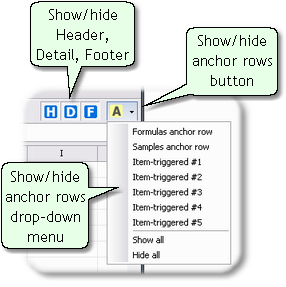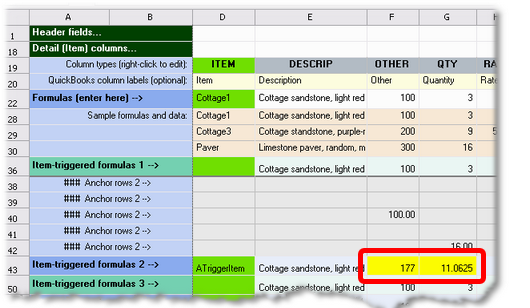Anchor rows allow your FormCalc SST formulas to refer to QuickBooks form data which won't actually be available until a form is being processed. In other words, they serve as "place holders" for QuickBooks data which will be available "later", when FormCalc SST is processing the form.
Where are They?
On the Snapshot page, every Detail area row which allows formula entry has at least one anchor row immediately above it. The Formulas and Sample formulas and data rows each have one anchor row:

Item-triggered formula rows each have five anchor rows, which allows them to support the mini-spreadsheet feature. This screenshot shows the anchor rows for the Item-triggered formulas 2 row:

But I don't see them on my Snapshot page...where are they?
You won't need anchor rows all of the time—and some people may never use them—so they are hidden by default. You can show or hide them by using the [ A ] button menu in the upper right corner of the main window:

How Do I Use Anchor Rows?
A common use for anchor rows is in formulas which compute a running total or other calculation involving data from the "prior" row on the form.
Here's an example. The following formula, entered on the Formulas row, refers to the anchor row in a way which will compute a running total in the Quantity column.

| For details, see the Running total calculation topic in How-To Examples. |
Another, more advanced, use of anchor rows is in building formulas which may refer to several prior rows of data. See the the mini-spreadsheet topic for a discussion of that technique.
Can I enter formulas or sample data in anchor rows?
You may enter sample data on them, but not formulas.
Entering example data on anchor rows is a way to create a "mock environment" for testing your formulas. This is especially helpful when several anchor rows are available, as for Item-triggered formula rows.
The following example from the mini-spreadsheet topic shows how data entered on anchor rows lets you see immediate results for formulas entered on the Item-triggered row. Without this example data (444.00 and 10.00) the first real test of those formulas would come when a QuickBooks form was actually processed.

| You can change data on anchor rows as often as you like, to see how your formulas work with different data. |